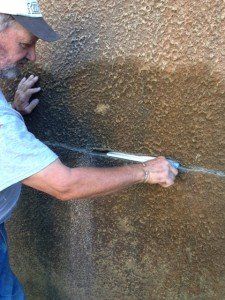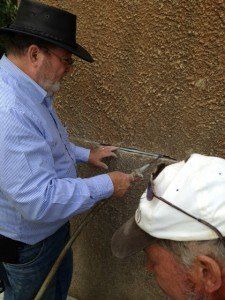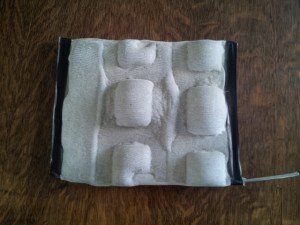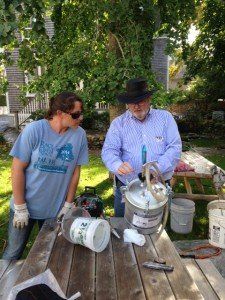Update: Conservation of the MMA Science Library Building
And we are off! In these photographs, you see island mason Wayne Morris along with his mason tender daughter, Andrea, the engineer, the grout and pillow anchor fabricator representative, and myself (we were a crowd!) testing the pillow anchors that are inserted into the holes they sawed into the northern façade of the MMA’s Science Library building. These pillow anchors, developed by John Wathne of Structures-North, an engineer who specializes in historic buildings and who has worked on Mitchell House, will be pumped with grout to a set PSI. In one image you see one that has been filled and resembles a pill package. Those areas were where holes in a cement block existed and where the grout filled the pillow and pushed up into the voids in the block. This is what will happen to the MMA building. The pillow will expand and fill the voids in the terracotta tiles of the NatCo system that make our building’s walls. This will stabilize the walls where you see cracking. Pillow anchors are not a new thing – they are typically long and resemble a sock. But these flat, square anchors were developed by the engineer specifically for our building.
Now that the test is complete, anchors and grout are on order. Scaffolding is up around the chimney on the back of the building where the mason will be re-pointing and rebuilding the top of the chimney which vents the furnace. Then, he will move to the front of the building and replace the steel lintels under the windows, install the pillow anchors, and repair the terracotta tiles where there has been map cracking. Once this work is complete, stucco will be reapplied to fill in the openings on the face of the building, work will be completed to the gutters and downspouts, and then painting will be completed to the building. The building will also likely get darker, returning to more of a grey tone as it was when it was built. All of this exterior work has been funded by the Community Preservation Act. Stay tuned as the work progresses!
JNLF
Recent Posts








